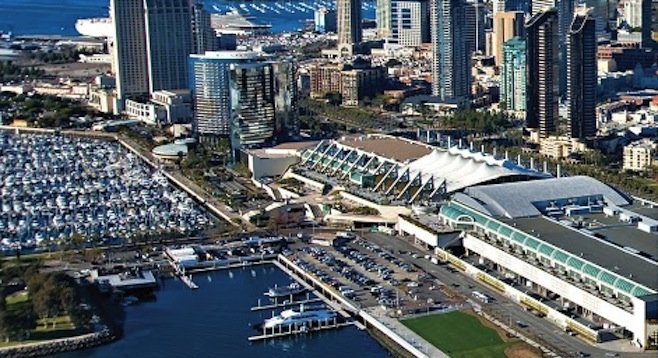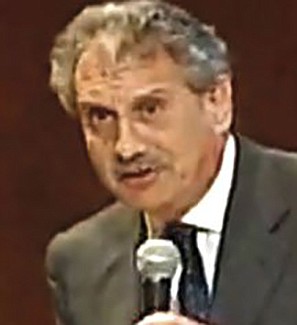 Facebook
Facebook
 X
X
 Instagram
Instagram
 TikTok
TikTok
 Youtube
Youtube

Heywood Sanders, professor at the University of Texas San Antonio, and the nation's ranking expert on convention centers, just visited San Diego. He is the author of the book Convention Center Follies, telling how convention centers are massively overbuilt and prices are plunging. (San Diego is cutting prices by 50 percent, as are other centers.)

For years, Sanders has been quoted in the Reader, challenging the San Diego Convention Center's published numbers and pointing out the follies of expansion — both in San Diego and elsewhere.
While he was here, he walked to the location that is now being tossed around as a possible combined convention center/domed football stadium, on land owned by John Moores. Sanders says that combined centers/stadiums don't work well.
"A stadium is not great convention center space. You only have about 150,000 square feet on the floor — pretty small."
If San Diego went ahead with such a project, "You would have two separate convention centers," says Sanders. Experience has shown that people attending one convention won't walk a long distance to get to the second one, and in this case, as Sanders found out, one goes over a pedestrian bridge over Harbor Drive, and then walks several blocks to the new location. There would have to be one convention in the new location, and another in the current one.
So, now the question becomes: would San Diego be able to sell out two centers? It's extremely doubtful. San Diego's numbers are pushed by Comic-Con and the Rock 'n' Roll Marathon. The latter should probably not be classified as a convention, because the attendees are mostly from the San Diego area. The former is questionable, too. Many Comic-Con attendees are from San Diego, Orange, and Los Angeles counties, and go home in the evening, thus not filling hotels or even restaurants. And there is controversy about how much Comic-Con attendees spend in restaurants and hotels. A lot of them are brown-baggers.
Here's a shocker: "It's not clear that, aside from the growth of Comic-Con and the Rock 'n' Roll Marathon, the center is doing better than it was in the late 1990s before the expansion," says Sanders. The expected attendance this year is 546,628. If you subtract Comic-Con and the Rock 'n' Roll Marathon, the number is attendance of 356,628. The center was expanded in 2001. So, go back to 1998 and 1999. Without Comic-Con and Rock 'n' Roll, attendance in 1998 was 287,947. In 1999, without Comic-Con and the marathon, it was 320,034. So, attendance has hardly grown impressively in more than a decade and a half.
Here's another shocker: In 2008, attendance was 478,159 without Comic-Con and the Rock 'n' Roll Marathon. Thus, the convention center has lost business since 2008, during the Great Recession.
It will be extremely difficult for any expansion — particularly one blocks away — to pay off.
San Diego gave John Moores land in the ballpark district for extremely low (early 1990s) prices. He raked in an estimated $700 million to $1 billion selling that land to developers. That's apart from the $300 million subsidy for the ballpark. Then San Diego put public projects, such as the library, near Moores's buildings so he could feast off infrastructure that he was paying little or nothing for, says former councilmember Bruce Henderson. Now some San Diegans want to buy land from Moores's company for a combined stadium-convention center that would probably be a white elephant.
"It's corporate welfare on steroids," says Henderson.


Heywood Sanders, professor at the University of Texas San Antonio, and the nation's ranking expert on convention centers, just visited San Diego. He is the author of the book Convention Center Follies, telling how convention centers are massively overbuilt and prices are plunging. (San Diego is cutting prices by 50 percent, as are other centers.)

For years, Sanders has been quoted in the Reader, challenging the San Diego Convention Center's published numbers and pointing out the follies of expansion — both in San Diego and elsewhere.
While he was here, he walked to the location that is now being tossed around as a possible combined convention center/domed football stadium, on land owned by John Moores. Sanders says that combined centers/stadiums don't work well.
"A stadium is not great convention center space. You only have about 150,000 square feet on the floor — pretty small."
If San Diego went ahead with such a project, "You would have two separate convention centers," says Sanders. Experience has shown that people attending one convention won't walk a long distance to get to the second one, and in this case, as Sanders found out, one goes over a pedestrian bridge over Harbor Drive, and then walks several blocks to the new location. There would have to be one convention in the new location, and another in the current one.
So, now the question becomes: would San Diego be able to sell out two centers? It's extremely doubtful. San Diego's numbers are pushed by Comic-Con and the Rock 'n' Roll Marathon. The latter should probably not be classified as a convention, because the attendees are mostly from the San Diego area. The former is questionable, too. Many Comic-Con attendees are from San Diego, Orange, and Los Angeles counties, and go home in the evening, thus not filling hotels or even restaurants. And there is controversy about how much Comic-Con attendees spend in restaurants and hotels. A lot of them are brown-baggers.
Here's a shocker: "It's not clear that, aside from the growth of Comic-Con and the Rock 'n' Roll Marathon, the center is doing better than it was in the late 1990s before the expansion," says Sanders. The expected attendance this year is 546,628. If you subtract Comic-Con and the Rock 'n' Roll Marathon, the number is attendance of 356,628. The center was expanded in 2001. So, go back to 1998 and 1999. Without Comic-Con and Rock 'n' Roll, attendance in 1998 was 287,947. In 1999, without Comic-Con and the marathon, it was 320,034. So, attendance has hardly grown impressively in more than a decade and a half.
Here's another shocker: In 2008, attendance was 478,159 without Comic-Con and the Rock 'n' Roll Marathon. Thus, the convention center has lost business since 2008, during the Great Recession.
It will be extremely difficult for any expansion — particularly one blocks away — to pay off.
San Diego gave John Moores land in the ballpark district for extremely low (early 1990s) prices. He raked in an estimated $700 million to $1 billion selling that land to developers. That's apart from the $300 million subsidy for the ballpark. Then San Diego put public projects, such as the library, near Moores's buildings so he could feast off infrastructure that he was paying little or nothing for, says former councilmember Bruce Henderson. Now some San Diegans want to buy land from Moores's company for a combined stadium-convention center that would probably be a white elephant.
"It's corporate welfare on steroids," says Henderson.
Comments